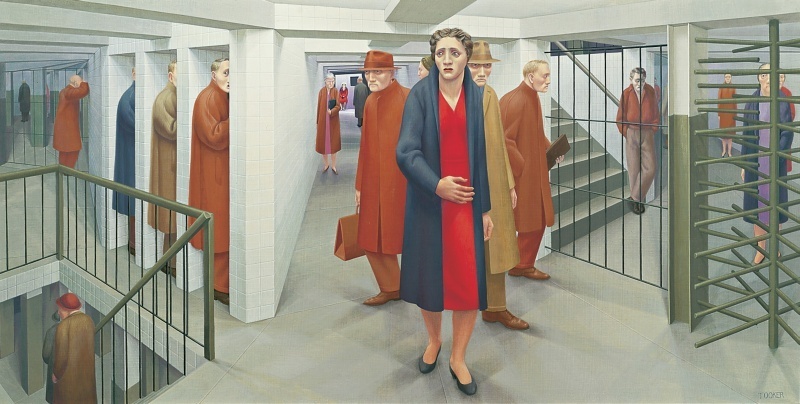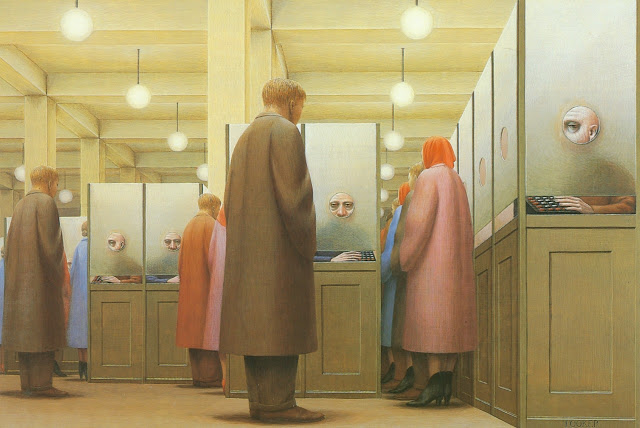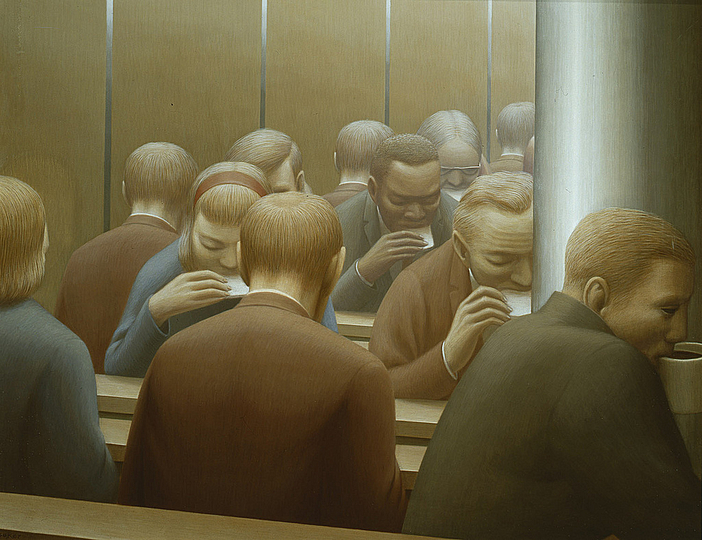ARTIST SPOTLIGHT: George Tooker
George Tooker, whose timeless artworks are immediatly recognizable, is one of the most enigmatic American painters of the 20th century. He has been considered a symbolic or magic-realist painter. However, he seems to be a figurative painter, but neither a symbolist nor a magic-realist. He also refused to be considered a surrealist artist −“I am after reality painting impressed on the mind so hard that it returns as a dream, but I am not after dreams as such, a fantasy”− and yet there is something mysterious about the way he depicted modern urban scenes, in what appears to be an otherworldly element juxtaposed with the mundane situations.
George Clair Tooker Jr. was born on August 5, 1920, in Brooklyn and grew up in Bellport (Long Island), where he studied painting with a local artist. Later he attended Harvard, where he studied English Literature, after graduating in Phillips Academy in Andover, Massachusetts.
 |
| George Tooker, by George Platt Lynes |
George Clair Tooker Jr. was born on August 5, 1920, in Brooklyn and grew up in Bellport (Long Island), where he studied painting with a local artist. Later he attended Harvard, where he studied English Literature, after graduating in Phillips Academy in Andover, Massachusetts.
He was a close friend
of the painter Paul Cadmus, who introduced him to egg-tempera technique. Jared
French was also part of his circle and had a great influence on Tooker’s
painting, especially the static, hieratic style, by which he painted those
characteristic inescrutable faces, in order to create a more mystifying
atmosphere. Along with Cadmus and French, his most personal influences, the features
of the Early Renaissance deeply pervaded his works. Tooker tried to emulate some painters, especially the rounded, simplified figures of Piero della Francesca and Masaccio. He also adopted the use of delicate colour from those artists and Domenico Veneziano.
 |
| Madonna di Senigallia, oil on wood by Piero della Francesca (1470-1475), Galleria Nazionale delle Marche, Urbino |
Among his favourite
themes, we find love, death, ageing, alienation (see Government Bureau below), intimacy, ethnic issues, and
religious faith –some pieces seem to mirror Christian scenes, for instance, Supper (1963), which could be an allusion to the supper at Emmaus depicted in the Gospel of Luke. But one of them takes pride of place throughout Tooker’s
career: the isolation and anonymity of modern urban life, by depicting worldly
experiences (see Subway and Lunch below). This way, he was an artist engaged with human matters, far from a strict Symbolism or Surrealism.
 |
| Subway, tempera on wood by George Tooker (1950), Whitney Museum of American Art, New Yor City |
 |
| Government Bureau, egg tempera on wood by George Tooker (1956), Metropolitan Museum of Art, New York City |
 |
| Lunch, egg tempera on gesso panel by George Tooker (1964), Columbus Museum of Art, Ohio |
However, not all his paintings harbour so dreadful and bleak subjects, especially after the death of his lifetime partner, William Christopher in 1973, when Tooker sunk into a spiritual crisis that he resolved by converting to Roman Catholicism. George Tooker died on March 27, 2011, in Hartland, Vermont.
Comments
Post a Comment